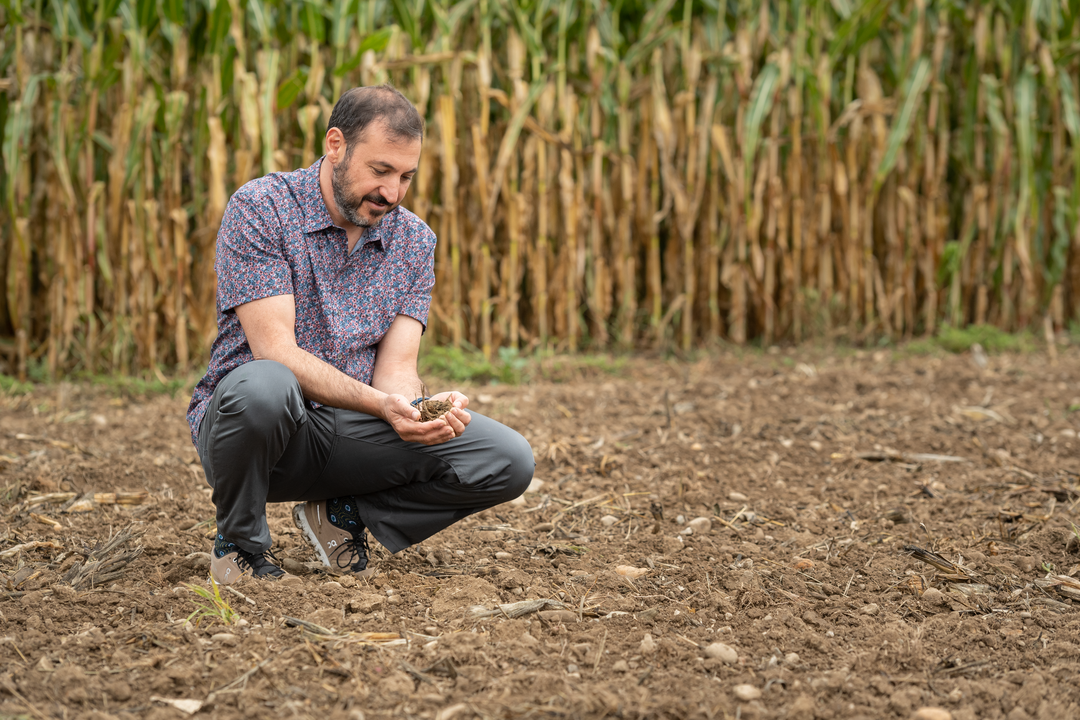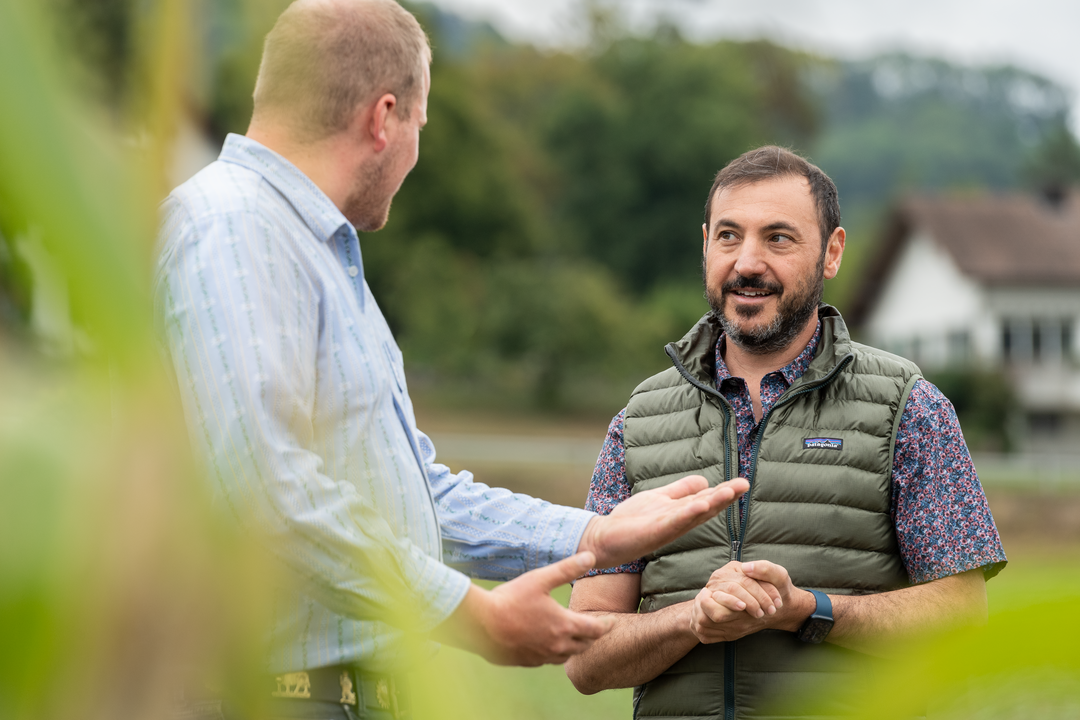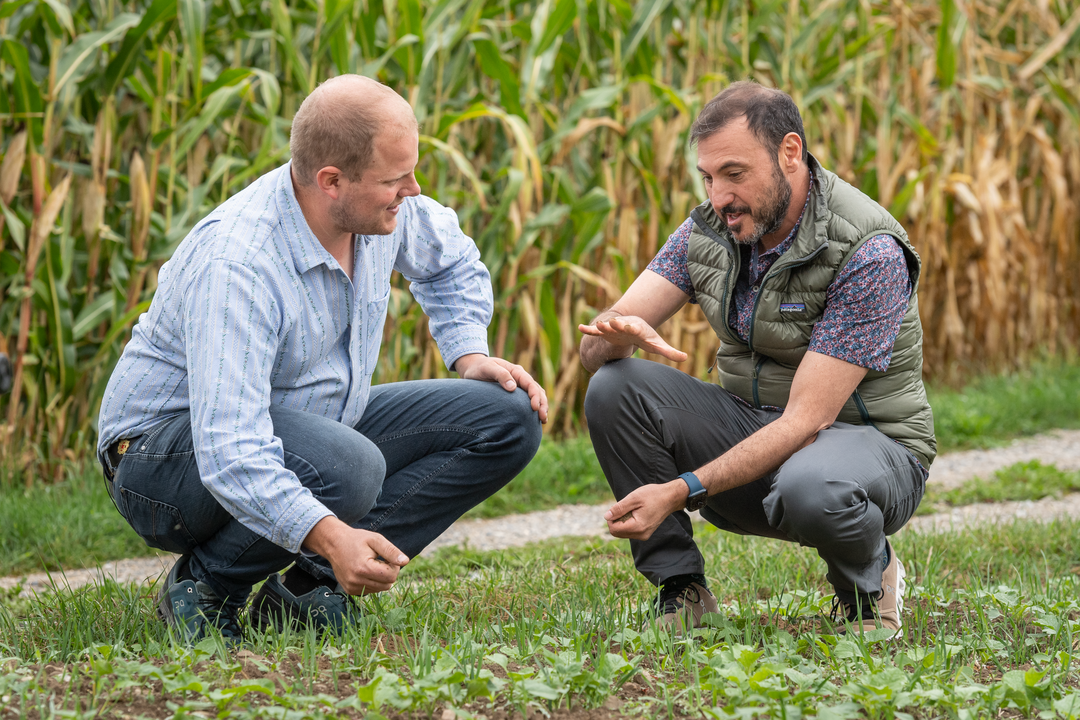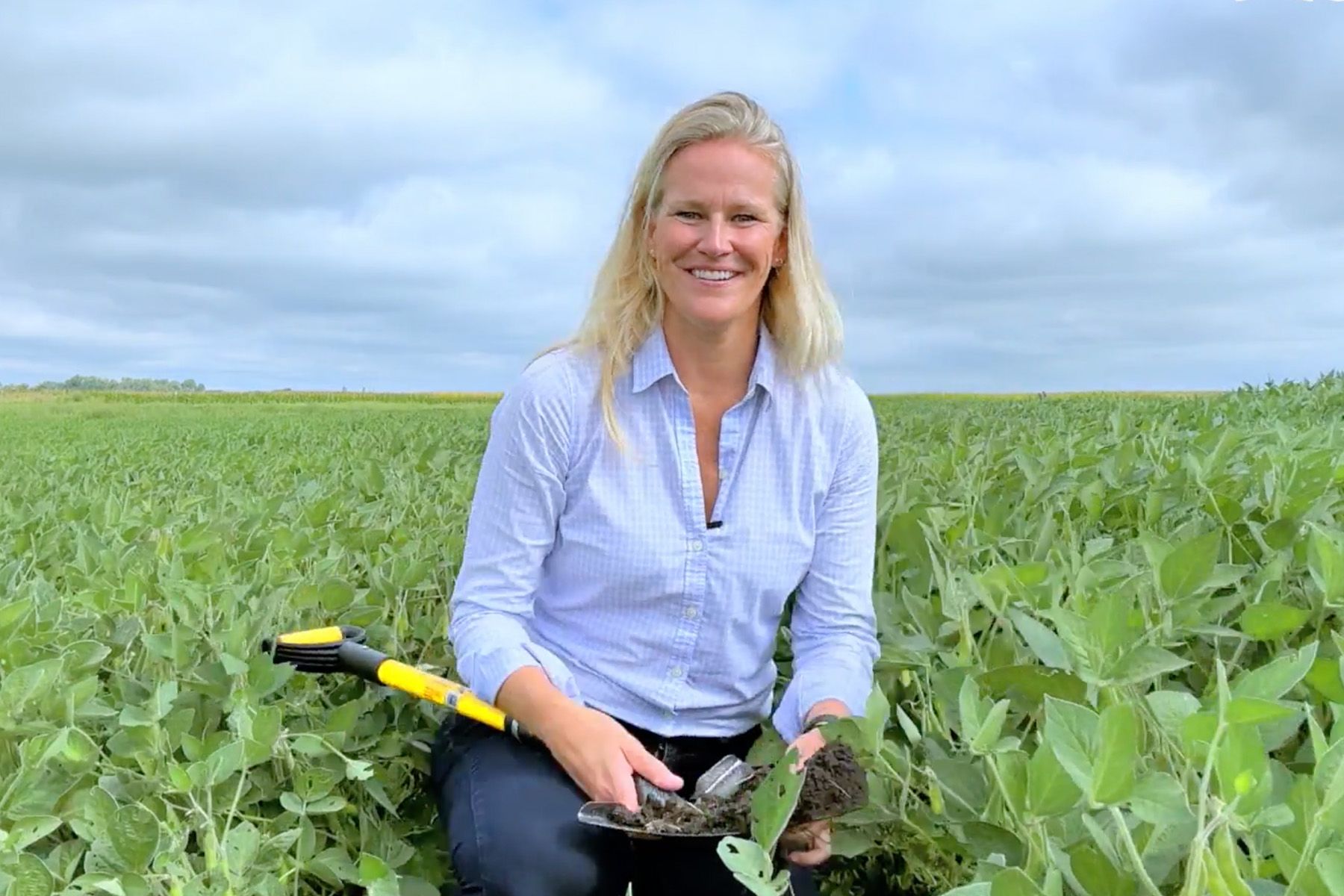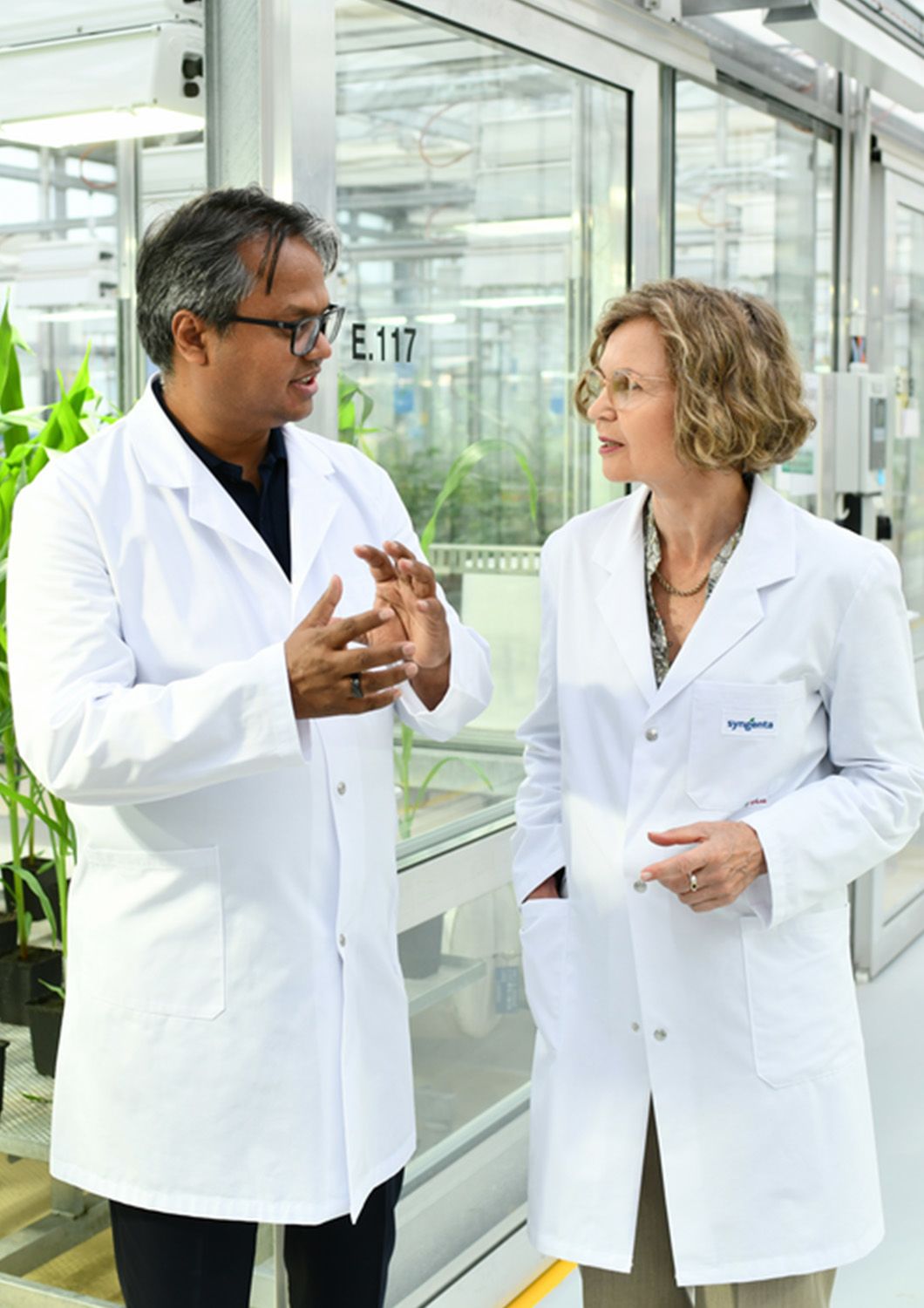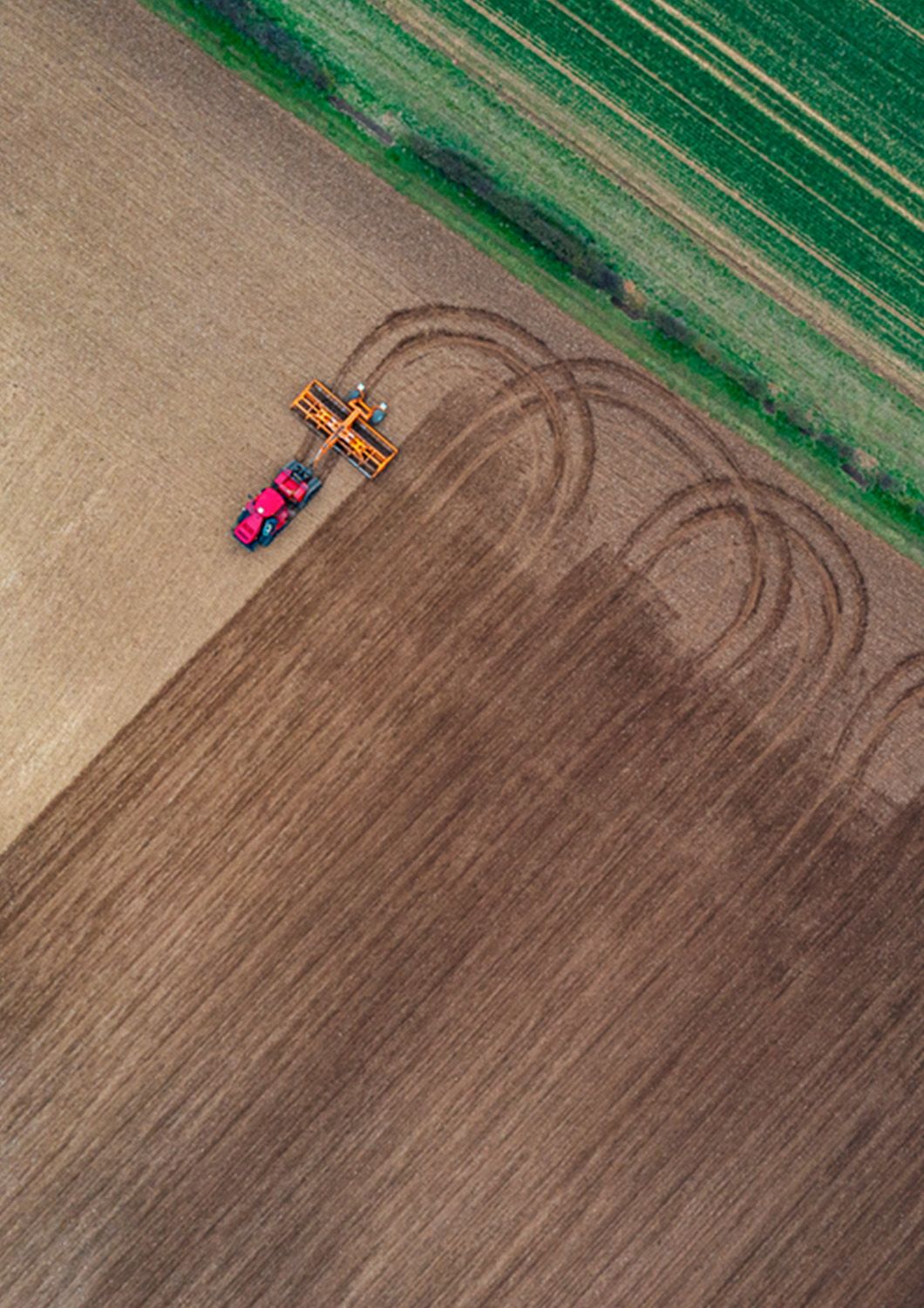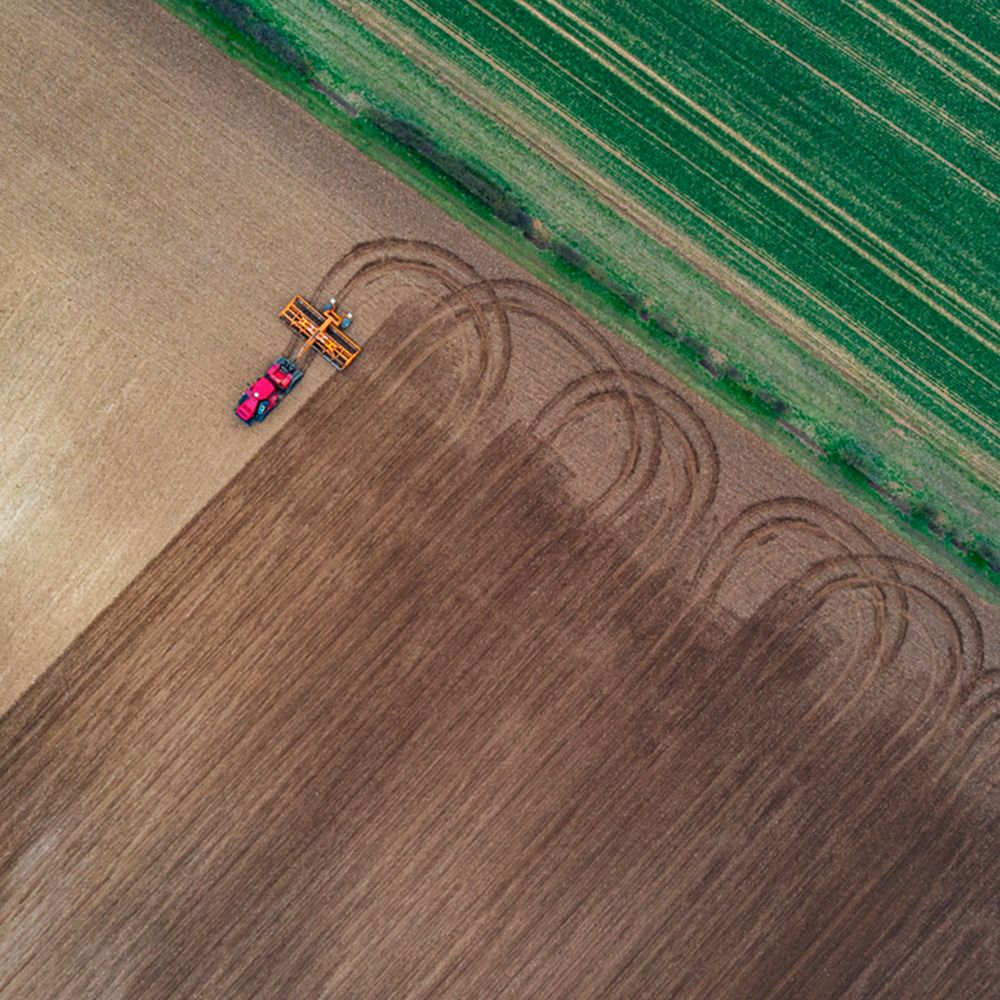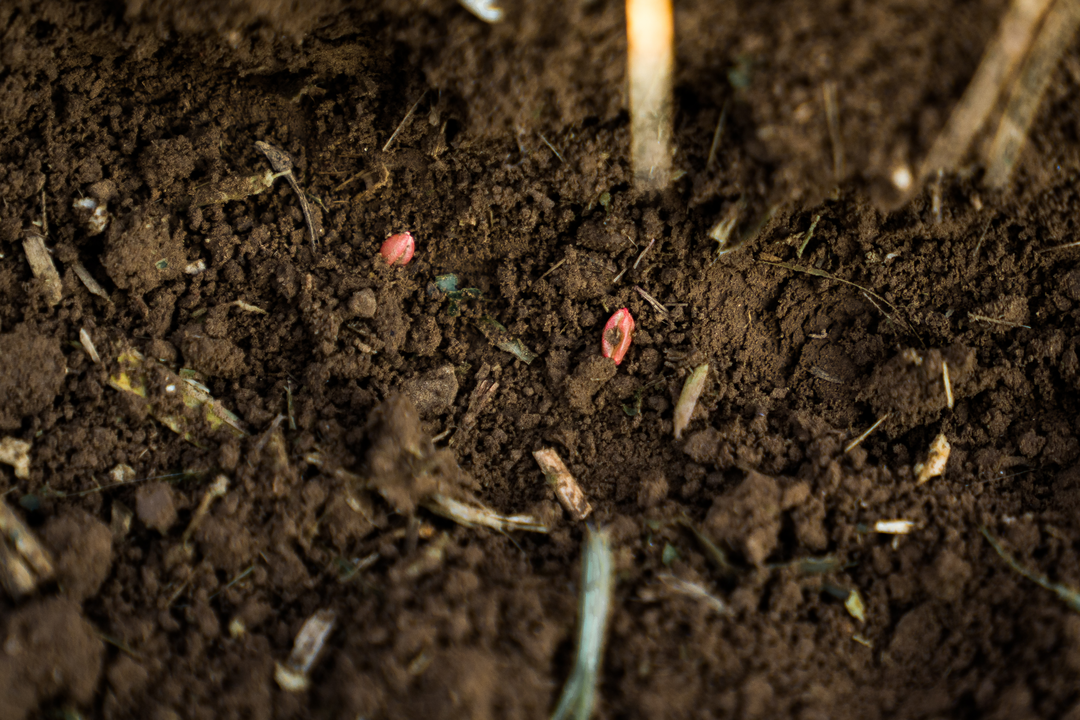Understanding Earth’s
most valuable resource
Digging into soil science - part one
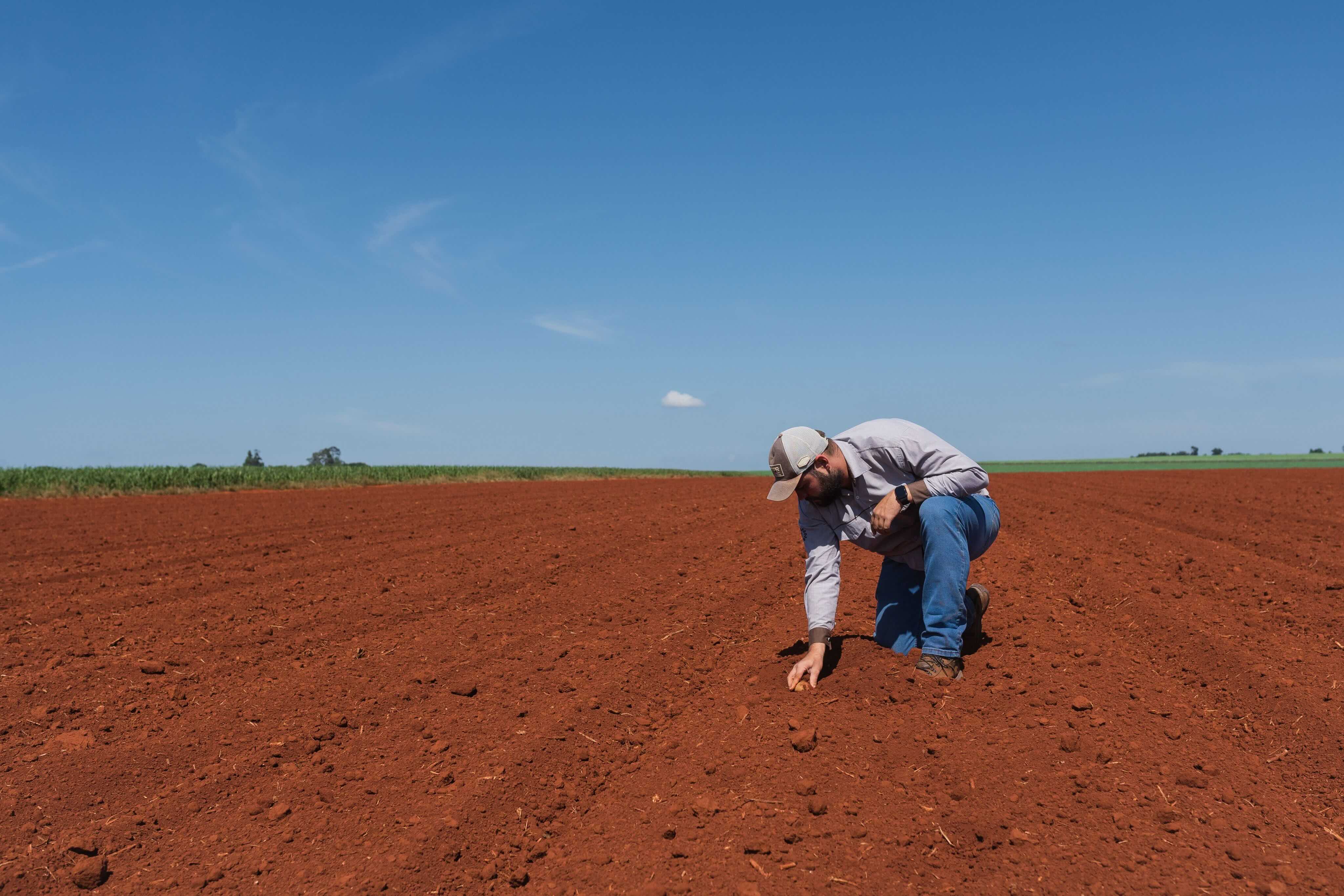
Bill McDonnell stoops to scoop up a handful of soil from his farm in the northern part of the U.S. state of Illinois. He holds the earth proudly, hefting what he considers one of his most valuable assets. The topsoil on McDonnell’s 1,000-acre farm typically produces the kind of highly abundant crop yields that give the U.S. corn belt its name.
McDonnell, who besides growing corn and soybeans is Syngenta’s digital solutions lead, knows a lot about the composition of the land he tends. The soil, he says, is primarily silty clay loam and silt loam. Lab analysis goes a step further, revealing the levels of phosphorus, potassium and carbon, as well as water-holding capacity, and other standard metrics.
Yet, despite his expertise and the deep science Syngenta invests in soil research, McDonnell acknowledges there’s still so much that’s unknown about the soil—whether on his farm or land under cultivation anywhere in the world.
“The most interesting way to think about our soil is not the parent material that makes it up,” he says, “but soil as a living organism.”
Syngenta scientist Jason Neff notes that even though agronomists know that the earth teems with microbial life that plays a critical role in soil health, the interactions and specific functions of those microbes still hold many mysteries. That includes microbes’ interaction with plant roots in the nitrogen cycle or their role in broader questions such as how agroecosystems respond to drought.
"Soil is incredibly physically, chemically, and biologically complex, and it's really all about the ecological interactions between those different components,” says Neff, Soil and Climate Innovation Principal Scientist at Syngenta. “We now understand how diverse it is, how complex it is.”
To better understand this fertile, yet complex ecosystem, McDonnell, Neff and other Syngenta experts are digging into soil science, literally. On working farms and in research facilities around the globe, they’re studying nutrients, irrigation, tillage, cover crops, and other variables in the maintenance, conservation, and restoration of soil.
As part of this effort, they use digital technologies, including satellite images, sensors, and state-of-the-art computing, to collect and analyze data. And increasingly, they’re employing artificial intelligence—including real-time AI analysis in crop fields, to detect fungal spores or other indicators of disease.
The potential to learn more about the makeup of soil holds great promise for the future of agriculture. This article is the first in a series that will explore the essential work underway to develop new data-driven insights into soil health and to apply those insights to productivity, innovation, and sustainability for farmers everywhere.
Bill McDonnell, Digital Solutions Lead
Bill McDonnell, Digital Solutions Lead
Bill McDonnell, Digital Solutions Lead
Bill McDonnell, Digital Solutions Lead
Jason Neff, Soil and Climate Innovation Principal Scientist
Jason Neff, Soil and Climate Innovation Principal Scientist
McDonnell, who besides growing corn and soybeans is Syngenta’s digital solutions lead, knows a lot about the composition of the land he tends. The soil, he says, is primarily silty clay loam and silt loam. Lab analysis goes a step further, revealing the levels of phosphorus, potassium and carbon, as well as water-holding capacity, and other standard metrics.
Yet, despite his expertise and the deep science Syngenta invests in soil research, McDonnell acknowledges there’s still so much that’s unknown about the soil—whether on his farm or land under cultivation anywhere in the world.
“The most interesting way to think about our soil is not the parent material that makes it up,” he says, “but soil as a living organism.”
Syngenta scientist Jason Neff notes that even though agronomists know that the earth teems with microbial life that plays a critical role in soil health, the interactions and specific functions of those microbes still hold many mysteries. That includes microbes’ interaction with plant roots in the nitrogen cycle or their role in broader questions such as how agroecosystems respond to drought.
"Soil is incredibly physically, chemically, and biologically complex, and it's really all about the ecological interactions between those different components,” says Neff, Soil and Climate Innovation Principal Scientist at Syngenta. “We now understand how diverse it is, how complex it is.”
To better understand this fertile, yet complex ecosystem, McDonnell, Neff and other Syngenta experts are digging into soil science, literally. On working farms and in research facilities around the globe, they’re studying nutrients, irrigation, tillage, cover crops, and other variables in the maintenance, conservation, and restoration of soil.
As part of this effort, they use digital technologies, including satellite images, sensors, and state-of-the-art computing, to collect and analyze data. And increasingly, they’re employing artificial intelligence—including real-time AI analysis in crop fields, to detect fungal spores or other indicators of disease.



The potential to learn more about the makeup of soil holds great promise for the future of agriculture. This article is the first in a series that will explore the essential work underway to develop new data-driven insights into soil health and to apply those insights to productivity, innovation, and sustainability for farmers everywhere.
The challenge of depleted soil
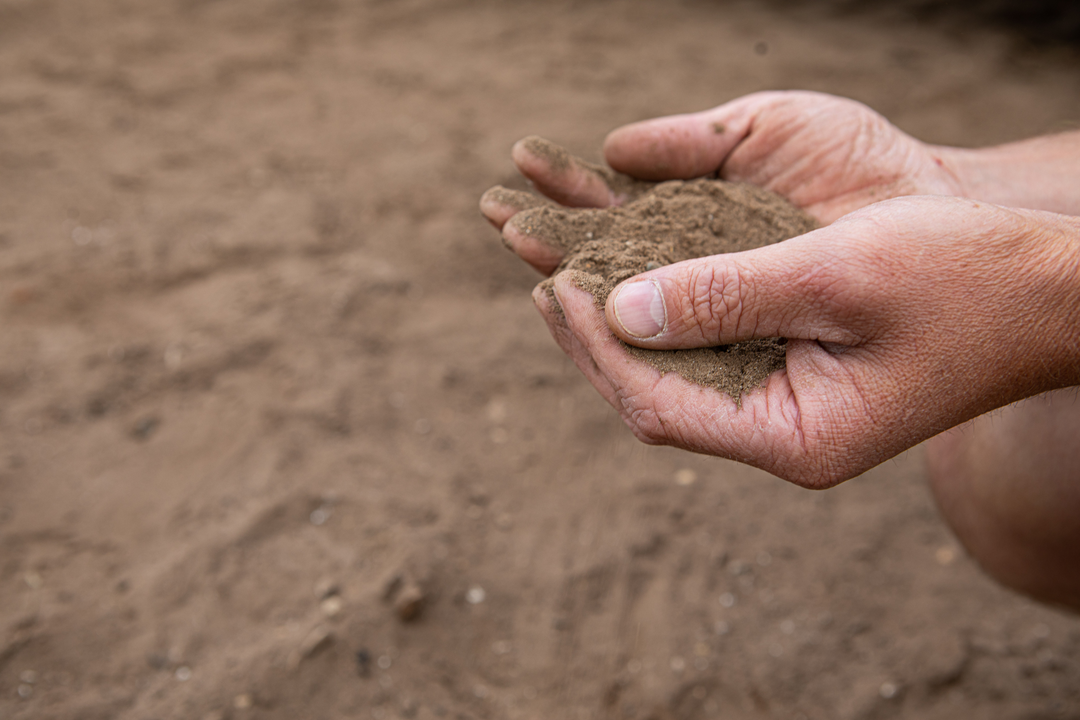
The top six inches of an acre of land can contain up to 5,000 pounds of macroscopic and microscopic organisms—those we can see with the naked eye—and tiny life forms that can be viewed only through a microscope, according to McDonnell, citing U.S. Department of Agriculture estimates. It’s a dynamic blend of air, water, minerals and organic materials—living and dead—that interact in remarkable ways.
This vibrant composition makes soil one of the most valuable resources on Earth, an asset that has a critical role to play in curbing climate change through soil’s ability to store carbon. Equally important, healthy soil is vital to ensuring food security for the growing global population.
Matthew Wallenstein, Chief Soil Scientist
Matthew Wallenstein, Chief Soil Scientist
The challenge, and urgency, of maintaining soil health has been mounting for years. On farms around the world—from the soy tracts of South America to the rice paddies of Asia to the corn of North America—formerly fertile lands have been gradually depleted of fertility, organic matter, and structure. There are many reasons soil loses its vitality, including overuse of chemical fertilizers; limited crop diversity; machine compaction; salt accumulation; and extensive plowing.
Unless farmers take corrective steps—such as regenerative practices and use of the latest agricultural products and technologies—the implications are worrisome. The risks include lower yields, reduced farm income, and increased vulnerability to climate extremes.
Matthew Wallenstein, Chief Soil Scientist and Michael Suter of Suter Hof, Hendschiken
Matthew Wallenstein, Chief Soil Scientist and Michael Suter of Suter Hof, Hendschiken
"Soil is the foundation not just for food production, but for planetary health that supports life on Earth,’’ says Matthew Wallenstein, Chief Soil Scientist, Syngenta Group. “It supports the plants that draw carbon out of the atmosphere and produce oxygen. Almost all our food comes from soil.”
Bottom line, Wallenstein says of soil: “We couldn't live without it.”
Progress has come with cost
Farmers and society in general have long benefited from nutrient-rich soils. Over the past century, increased yield efficiency has dramatically boosted production. For instance, the amount of corn (or maize as it’s known in many parts of the world) produced annually is almost 20 times higher today than 150 years ago, even though the land devoted to its cultivation has merely doubled.
But these advances have come at a cost. Wallenstein estimates that fully half of the world’s soil now needs restoration.
“Our ability to utilize the soil resource for agriculture was part of the reason that the human population expanded over the last century,” Wallenstein says. “But the way we did it also degraded the soil and threatens our future sustainability.”
The urgency of addressing soil health has become a global concern. According to the United Nations Food and Agriculture Organization, 90 percent of the Earth's topsoil will be at risk by 2050. This degradation is happening at an alarming rate, with a soccer-field equivalent of soil being eroded every five seconds. At that rate, the world is losing 100 million hectares—or more than 247 million acres—of productive land each year, roughly twice the size of Greenland and impacting nearly two-fifths of humanity, according to the UN organization.
Going forward, how this plays out is part science and part practice. Research findings must carry over into soil-aware, sustainable implementation.
Dr. Abbey Wick, Soil Health Academy Group Leader
Dr. Abbey Wick, Soil Health Academy Group Leader
“What helps on the farm is support and risk reduction, which can be based on the new scientific findings,” says Abbey Wick, group leader of Syngenta’s Soil Health Academy. The important thing, she adds, is to apply that knowledge to practical farming methods that protect and respect the soil.
Scientific, data-driven solutions for soil health

Syngenta’s science-driven, data-led approach toward preserving and restoring soil health is helping to further our understanding of how soil works and how to begin repairing the damage. In just one example, soil scientists at Syngenta’s research facility in Stein, Switzerland, are delving into the effect nitrogen-fixing products have on soil microbiome and yield outcomes. They are also studying how Syngenta technologies designed to control for soil-borne diseases and pests can simultaneously benefit soil health and biodiversity.
Soil-protective or -enhancing solutions by Syngenta include seed varieties bred to be best suited to local conditions; nature-based biostimulants that can fortify plants without damaging the environment; and crop-protection molecules developed to fight pests and diseases while sparing the many beneficial microbes in soil.
"Regenerating soil and nature while increasing land productivity is a key challenge we face as a society, and that’s why it’s one of our four new sustainability priorities,” says Petra Laux, Chief Sustainability Officer at Syngenta Group. Those priorities are meant to ensure that the products the company develops and sells are making measurable improvements in sustainable agriculture.
Regenerative agriculture practices such as minimal tillage, cover cropping, and crop diversification are also central to the sustainability effort. These methods are crucial for improving soil health and optimizing fertilizer application.
Regenerative farming can also reduce the greenhouse emissions associated with farming—whether by cutting back on the need for chemical fertilizers that are energy intensive to produce; by reducing the use of heavy diesel-burning farm machinery; or by preserving soil’s ability to sequester the carbon dioxide that crop plants capture from the atmosphere and store in the ground.
Meanwhile, cutting-edge technologies like soil sensors, drones and satellite imagery are enabling farmers to gather much more data about the soil—and the health of vast areas of farmland—than was possible just a decade ago. This data aids in the precise use of crop-enhancing or -protecting chemicals to support biodiversity and maintain soil health.
“If you know how your phosphorus levels vary across your field,’’ Jason Neff offered as an example, “then you only fertilize the areas that need phosphorus. And you don't fertilize areas that don't need it.”
Feroz Sheikh, Group Chief Information and Digital Officer; Petra Laux, Chief Sustainability Officer
Feroz Sheikh, Group Chief Information and Digital Officer; Petra Laux, Chief Sustainability Officer
Feroz Sheikh, Group Chief Information and Digital Officer; Petra Laux, Chief Sustainability Officer
Feroz Sheikh, Group Chief Information and Digital Officer; Petra Laux, Chief Sustainability Officer
Syngenta’s science-driven, data-led approach toward preserving and restoring soil health is helping to further our understanding of how soil works and how to begin repairing the damage. In just one example, soil scientists at Syngenta’s research facility in Stein, Switzerland, are delving into the effect nitrogen-fixing products have on soil microbiome and yield outcomes. They are also studying how Syngenta technologies designed to control for soil-borne diseases and pests can simultaneously benefit soil health and biodiversity.
Soil-protective or -enhancing solutions by Syngenta include seed varieties bred to be best suited to local conditions; nature-based biostimulants that can fortify plants without damaging the environment; and crop-protection molecules developed to fight pests and diseases while sparing the many beneficial microbes in soil.
"Regenerating soil and nature while increasing land productivity is a key challenge we face as a society, and that’s why it’s one of our four new sustainability priorities,” says Petra Laux, Chief Sustainability Officer at Syngenta Group. Those priorities are meant to ensure that the products the company develops and sells are making measurable improvements in sustainable agriculture.
Regenerative agriculture practices such as minimal tillage, cover cropping, and crop diversification are also central to the sustainability effort. These methods are crucial for improving soil health and optimizing fertilizer application.
Regenerative farming can also reduce the greenhouse emissions associated with farming—whether by cutting back on the need for chemical fertilizers that are energy intensive to produce; by reducing the use of heavy diesel-burning farm machinery; or by preserving soil’s ability to sequester the carbon dioxide that crop plants capture from the atmosphere and store in the ground.
Meanwhile, cutting-edge technologies like soil sensors, drones and satellite imagery are enabling farmers to gather much more data about the soil—and the health of vast areas of farmland—than was possible just a decade ago. This data aids in the precise use of crop-enhancing or -protecting chemicals to support biodiversity and maintain soil health.
“If you know how your phosphorus levels vary across your field,’’ Jason Neff offered as an example, “then you only fertilize the areas that need phosphorus. And you don't fertilize areas that don't need it.”
Feroz Sheikh, Group Chief Information and Digital Officer; Petra Laux, Chief Sustainability Officer
Feroz Sheikh, Group Chief Information and Digital Officer; Petra Laux, Chief Sustainability Officer
Feroz Sheikh, Group Chief Information and Digital Officer; Petra Laux, Chief Sustainability Officer
Feroz Sheikh, Group Chief Information and Digital Officer; Petra Laux, Chief Sustainability Officer
Innovations in soil management
Syngenta’s “Farm of the Future,” a 152-acre site that is co-located with Bill McDonnell’s Illinois farm, has been a living laboratory for soil science since 2020. It employs digital technologies that include algorithms to determine seed selection by soil type, sensors to detect diseases before they spread, and drones for precise weed control. Baseline soil samples are analyzed in a soil lab for fertility, organic matter and water-holding capacity.
McDonnell manages the Farm of the Future. "Traditionally it took 5 to 10 years to see a soil benefit with cover crops,’’ he says. “But we are already seeing increases in soil organic matter, water-holding capacity and soil organic carbon within the first three years.”
Together, regenerative agriculture and soil health technologies will help farmers make their crops more resilient in the face of climate change, Matt Wallenstein adds. “I would guess that about a quarter of the variation in crop productivity is due to soil health. Soil is the next frontier to unlock rapid improvements in productivity and profitability.”
Harnessing data
and AI

Data capabilities are transforming soil science. By leveraging machine learning and cloud-based computing, Syngenta is making soil health monitoring scalable and accessible. This approach helps in deploying effective agronomic solutions tailored to various soil conditions, according to Jeremy Groeteke, Syngenta’s Head of Computational Agronomy.
The team that Groeteke oversees includes an agronomist, agronomic modelers, soil-fertility specialists, and team members with degrees in computer science or AI. “We are using machine learning with data from remote and ground sensors to build an ensemble model to predict soil health,” Groeteke says. “With AI, we will be able to dig into more of this data.”
Bill McDonnell, Jeff Rowe - CEO, Syngenta Group, and Jeremy Groeteke
Bill McDonnell, Jeff Rowe - CEO, Syngenta Group, and Jeremy Groeteke
Longer term, Jason Neff is hoping for new ways to collect and analyze soil data that so far has been elusive. The next breakthrough, he says, will be more precise monitoring of soil’s microscopic life.
“We're hopeful of finding ways to move into that space, gaining detailed insights and using that to optimize yields,” Neff says. “Once we have datasets on agronomic interventions, AI and machine learning will help create predictive models, preparing us for future challenges.”
Future prospects for soil health
Matt Wallenstein knows that the advances in soil science can’t stay in the lab. “As we gain this knowledge, we need to translate that into actionable intelligence for farmers.”
Getting the necessary additional data and insights will take some time, and will depend on advances in computing itself — like continued progress with quantum computers. In contrast to conventional computers, which break information down into binary, either-or considerations, quantum computers can more fully analyze nature’s complexities by measuring the fluid, in-between states of real-time biological processes. Understanding those real-life functions could yield new understanding of how photosynthesis actually works, or the continual give-and-take between plants and the microbes in the soil.
“At the moment, we lack extensive high-quality soil datasets, which limits machine learning,” Wallenstein says. “As we continue collecting more data from soils worldwide, we will be able to connect diversity and functional data to agronomic outcomes through sophisticated predictive models.”
So far, despite the many advances in soil science, much about the life-giving properties of soil remains a mystery. Syngenta’s efforts to solve this intricate puzzle underscores a commitment not only to improving agricultural outcomes but to preserving one of the planet’s most vital resources — the soil — for future generations.
🌱 Unlocking the Secrets of Soil: Syngenta's Cutting-Edge Approach to Sustainable Agriculture





